Out of nowhere I received a new, very serious-looking book called, simply, Design Dictionary. Bam. No questions asked. The book arrived in a box from Amazon.com, despite my lack of orders from the online merchandiser in recent days — but being a design book lover I did not question my lucky arrival and proceeded to puncture the protective inflatables and rummage the box’s contents. The bright yellow cover, sparser than The New Typography and sprinkled with metallic arrows, had just slightly more clues as to where this had come from: BIRD. Or, the Board of International Research in Design, an enclave of design thinkers housed by Berlin-based Birkhäuser, the publisher of this book. Further intrigued, I did an eager flip-through and could not help contain a wicked laugh. This book, aside from arrows, birds, and some thin rules had absolutely no other imagery or visual cues in its 460-plus pages of densely set text. I bellowed in my mind, a la Jack Nicholson, “You want Graphic Design? You can’t handle Graphic Design!”
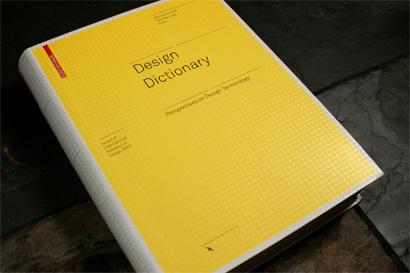
Cover of Design Dictionary.
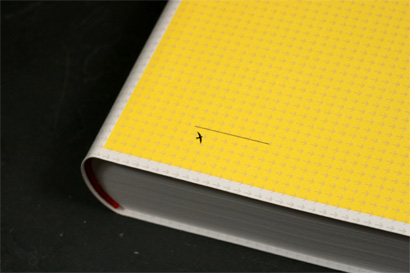
Detail of the little birdie, a device for BIRD, the Board of International Research in Design.
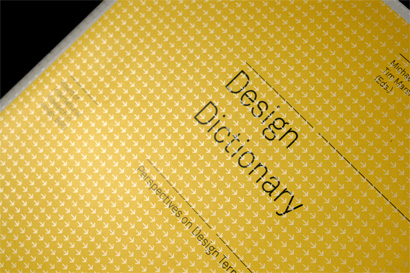
Metallic arrows give the spare cover a lovely texture.
Design Dictionary , as its name implies and as its subtitle, Perspectives on Design Terminology, elaborates is a comprehensive tome of more than 250 definitions extracted from the world of design, each written by one of the 110 contributors from around the globe. A truly impressive and unenviable effort, with a result that is nothing short of astounding. Design Dictionary is relentless, covering extremely specific terms like Flyer — “Leaflets that advertise mainly local services and upcoming events. […]” — to inexorably broad subjects like Design Process — “[Designers] are trained to conceptualize the process of design as a series of activities that unfold over time, and to view the completion of each activity as a step toward some predefined goal. […]” which, in contrast to the way brand consultancies explain their design process, is a sobering antacid. I could endlessly keep giving you examples, as Design Dictionary is surprisingly thorough in its inclusion, despite its editors fears: “We gave serious thought to the linguistic categories and terminology that underpin design discourse today. That said, it became clear while working on the book that we had omitted a number of valuable terms. This fact will undoubtedly be the subject of critique by reviewers and readers alike, and we expect that the project will provoke as many questions as it will answers.”
To add a layer of complexity to an already risky book, the editors — Michael Erlhoff, a professor at the Köln International School of Design in Germany, and Tim Marshall, dean at Parsons The New School for Design in New York — published Design Dictionary in both English and German. Without the ability to simply translate most terms, they were cautious to make sure that the linguistic choices of the entries were culturally relevant to each audience and adapt to colloquialisms that would be global enough not to discourage anyone from finding this book useful.
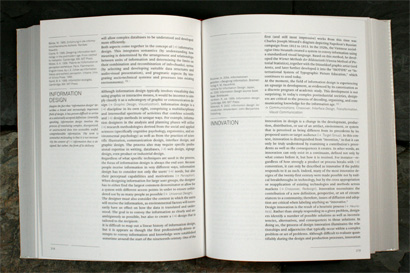
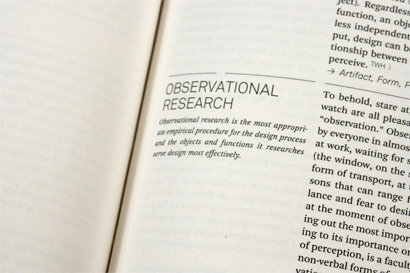
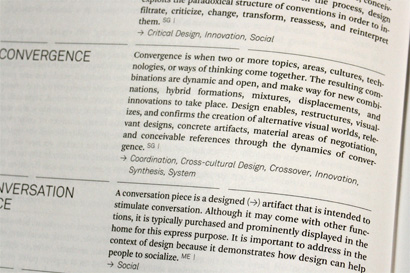
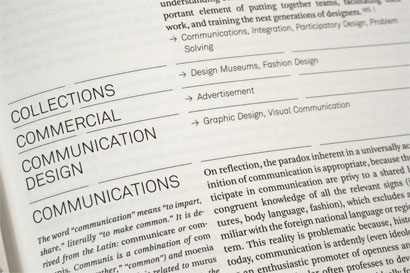
Sample spread and details from the inside, set in Akkurat and Arnhem, establishing a very pleasant design given the book’s unrepentant sameness.
I guess I must disclaim that I have not read this book cover to cover. I dare anyone to do so in a single swoop and remain a happy person. So I won’t be able to vouch for the entire book, much less for any specific wrongdoings — I will leave that to more heady critics. Nonetheless, even though I had plenty of work to do that afternoon, I could not put the book down, and in the days since receiving that mysterious box I have kept the Design Dictionary on my side table and pick it up anytime I have a lull between exporting InDesign files to PDFs or while talking to someone at customer service of whatever service has most recently stopped servicing, and I leaf randomly to see what term catches my attention. I’m not sure what use I find in this book, but I am continually intrigued by how each entry is defined — each a small battle to wage against an otherwise loosely defined profession that lacks any authoritative definitions on anything. For students and teachers this must be an invaluable book as it serves as one of the most concisely broad documents that explains the wording we communicate with every single day, and it is perhaps the best complement — if not vice versa — to the visual reference books graphic designers turn to continually.
So, whoever sent me this book: Thank you.






I sometimes wonder what inspires people to write design books. To the best of my knowledge, they don't sell very well (if Hjalti Karlsson and Jan Wilker are to be believed, anyways). I've come to the conclusion that many design books are created and produced for the sole purpose of making people like me wonder why people like them write said books. This is a great example of a book that makes me just go "Why?". Fortunately for them, I love filling my collection with books that make others wonder "Why does he have this?". I'll have to pick this up some day soon.
On Apr.02.2008 at 10:16 PM